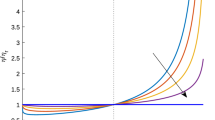Abstract
This paper proposes a novel structural derivative approach to tackle the perplexing modeling problem of ultraslow diffusion. The structural function plays a central role in this new strategy as a kernel transform of underlying time-space fabric of physical systems. Ultraslow diffusion has been observed in numerous lab experiments and field observations, whose behaviors deviate dramatically from the standard anomalous diffusion models characterizing power function of time. The logarithmic diffusion model has since been used to describe bizarre process of ultraslow diffusion but with very limited success. This study applies the inverse Mittag-Leffler function as the structural function in the structural derivative modeling ultraslow diffusion of a random system of two interacting particles. It is observed that the dynamics of two interacting particles are respectively the ballistic motion at the short time scale and the Sinai ultraslow diffusion at the long time scale. Compared with the logarithmic diffusion model, the inverse Mittag-Leffler diffusion model has higher accuracy and manifests clearer physical mechanism. Numerical experiments show that the structural derivative is a feasible mathematical tool to model the ultraslow diffusion using the inverse Mittag-Leffler function as its structural function.
Similar content being viewed by others
References
S.D.T. Arias, X. Waintal, J.L. Pichard, Two interacting particles in a disordered chain III: Dynamical aspects of the interplay disorderinteraction. Eur. Phys. J. B 10 (1999), 149–158.
F. Bowman, Introduction to Bessel Functions. Courier Corporation (2012).
C.B. Boyer, U.C. Merzbach, A History of Mathematics. John Wiley Sons (2011).
E.B. Brauns, M.L. Madaras, R.S. Coleman, et al., Complex local dynamics in DNA on the picosecond and nanosecond time scales. Phys. Rev. Lett. 88 (2002), Article # 158101.
M. Caputo, M. Fabrizio, A new definition of fractional derivative without singular kernel. Progr. Fract. Differ. Appl. 1 (2015), 73–85.
W. Chen, Time-space fabric underlying anomalous diffusion. Chaos Soliton. Fract. 28 (2006), 923–929.
W. Chen, Implicit calculus modeling for simulation of complex scientific and engineering problems. Comput. Aided E 23 (2014), 1–6 (In Chinese).
W. Chen, X. Hei, Y. Liang, Fractional kernel derivative model for ultraslow diffusion. Appl. Math. Mech. 37, No 6 (2016), 599–608 (In Chinese).
W. Chen, Y. Liang, S. Hu S, et al., Fractional derivative anomalous diffusion equation modeling prime number distribution. Fract. Calc. Appl. Anal. 18, No 3 (2015), 789–798; DOI: 10.1515/fca-2015-0047; https://www.degruyter.com/view/j/fca.2015.18.issue-3/issue-files/fca.2015.18.issue-3.xml.
W. Chen, Y. Liang, X. Hei, Local structural derivative and its applications. Chinese J. Solid Mech. 37, No 5 (2016), 1–5 (in Chinese).
W. Chen, G. Pang, A new definition of fractional Laplacian with application to modeling three-dimensional nonlocal heat conduction. J. Comput. Phys. 309 (2016), 350–367.
M. Cardona, R.V. Chamberlin, W. Marx, The history of the stretched exponential function. Ann. Phys.-Berlin 16 (2007), 842–845.
A. Ehsani, M.G. Mahjani, M. Bordbar, et al., Electrochemical study of anomalous diffusion and fractal dimension in poly ortho aminophenol electroactive film: Comparative study. J. Electroanal. Chem. 710 (2013), 29–35.
R. Gorenflo, A.A. Kilbas, F. Mainardi, S. Rogosin, Mittag-Leffler Functions, Related Topics and Applications. Springer, Berlin (2014).
J.W. Hanneken, B.N. Achar, Finite series representation of the inverse Mittag-Leffler function. Math. Probl. Eng. 2014 (2014), Article # 252393.
G.H. Hardy, Gosta Mittag-Leffler. J. Lond. Math. Soc. 1 (1928), 156–160.
R. Hilfer, H.J. Seybold, Computation of the generalized Mittag-Leffler function and its inverse in the complex plane. Integr. Transf. Spec. Func. 17 (2006), 637–652.
F. Hofling, T. Franosch, Anomalous transport in the crowded world of biological cells. Rep. Prog. Phys. 76 (2013), Article # 046602.
C. Ingo, R.L. Magin, L. Colon-Perez, et al., On random walks and entropy in diffusion-weighted magnetic resonance imaging studies of neural tissue. Magnetic Reson. Med. 71 (2014), 617–627.
I. Karatzas, S. Shreve, Brownian Motion and Stochastic Calculus. Springer Science Business Media (2012).
Y. Liang, W. Chen, R.L. Magin, Connecting complexity with spectral entropy using the Laplace transformed solution to the fractional diffusion equation. Physica A 453 (2016), 327–335.
Y. Liang, A.Q. Ye, W. Chen, et al., A fractal derivative model for the characterization of anomalous diffusion in magnetic resonance imaging. Commun. Nonlinear Sci. Numer. Simulat. 39 (2016), 529–537.
M.A. Lomholt, L. Lizana, R. Metzler, et al., Microscopic origin of the logarithmic time evolution of aging processes in complex systems. Phys. Rev. Lett. 110 (2013), Article # 208301.
F. Mainardi, Fractional Calculus and Waves in Linear Viscoelasticity: An Introduction to Mathematical Models. World Scientific (2010).
K. Matan, R.B. Williams, T.A. Witten, et al., Crumpling a thin sheet. Phys. Rev. Lett. 88 (2002), Article # 076101.
R. Metzler, J.H. Jeon, A.G. Cherstvy, et al., Anomalous diffusion models and their properties: non-stationarity, non-ergodicity, and ageing at the centenary of single particle tracking. Phys. Chem. Chem. Phys. 16 (2014), Article # 24128.
R. Metzler, J. Klafter, The random walk’s guide to anomalous diffusion: a fractional dynamics approach. Phys. Rep. 339 (2000), 1–77.
M.D. Ortigueira, J.A.T. Machado, Fractional signal processing and applications. Signal Process. 83 (2003), 2285–2286.
L.P. Sanders, M.A. Lomholt, L. Lizana, et al., Severe slowing-down and universality of the dynamics in disordered interacting many-body systems: ageing and ultraslow diffusion. New J. Phys. 16 (2014), Article # 113050.
R. Schumer, M.M. Meerschaert, B. Baeumer, Fractional advection dispersion equations for modeling transport at the Earth surface. J. Geophys. Res: Earth Surf. 114 (2009), Article # F00A07.
Y.G. Sinai, The limiting behavior of a one-dimensional random walk in a random medium. Theor. Probab. Appl. 27 (1983), 256–268.
H.E. Stanley, S. Havlin, Generalisation of the Sinai anomalous diffusion law. J. Phys. A-Math. Theor. 20 (1987), Article # L615.
A. Vaknin, Z. Ovadyahu, M. Pollak, Aging effects in an Anderson insulator. Phys. Rev. Lett. 84 (2000), Article #3402.
Y. Zhou, Basic Theory of Fractional Differential Equations. World Scientific, Singapore (2014).
Author information
Authors and Affiliations
About this article
Cite this article
Chen, W., Liang, Y. & Hei, X. StructuRal Derivative Based on Inverse Mittag-Leffler Function for Modeling Ultraslow Diffusion. FCAA 19, 1250–1261 (2016). https://doi.org/10.1515/fca-2016-0064
Received:
Published:
Issue Date:
DOI: https://doi.org/10.1515/fca-2016-0064



